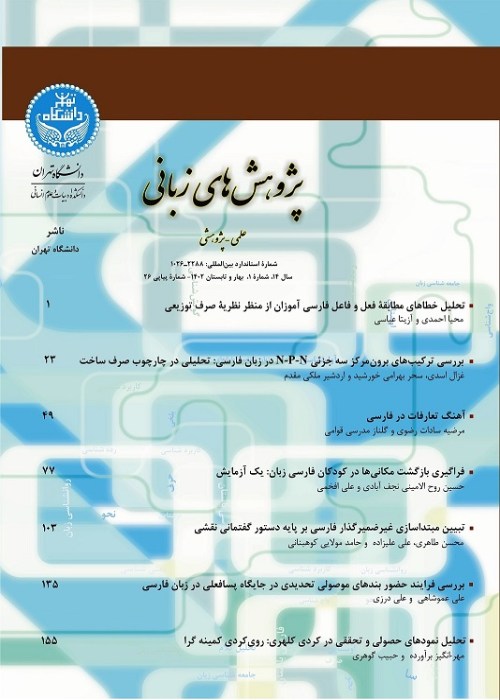There is no Stem: the Distribution of Verbal Allomorphs, a Distributed Morphology Analysis
Author(s):
Article Type:
Research/Original Article (دارای رتبه معتبر)
Abstract:
It is widely accepted by traditional grammarians and linguists that Persian verbal roots fall into two forms depending on their tense feature: present stem and past stem. In contrast to this traditional view, the present study considers an alternative notion of allomorphy, indicating that a few verbs use a basic form, called “morph”, in all morphosyntactic contexts while some other roots allow for having two or more allomorphs. Within the framework of Distributed Morphology, especially on the basis of underspecification condition, I will review the empirical evidence adduced in favor of the hypothesis that the tense feature has no role in producing and selecting the so-called present and past stems. In this approach, the systematic distribution of verbal allomorphs like /suz/ and /sux/ (derived from “ÖSUZ” = burn) is constrained by some other formal features, such as adjacency to the morphophoneme {D}, absorbing the causative suffix (“-ān” or its free variation “-un”) or appearing in the boundary of a word. Finally, to avoid terminological and empirical confusion, I will suggest that we should avoid the use of the term “stem” altogether and speak of root, morph and allomorphs only. It should be added that the different variations in phonetic shape of lexical roots are divided into two classes: the first one follows from the phonological rules and the second one is affected by the morphophonological (or readjustment) rules. Phonological changes are predictable and produce automatic alternations, but unpredictable morphophonological changes lead to non-automatic alternations. Following the general trend of DM, I restrict the term “allomorphy” to those cases in which the variation in phonetic shape of a morpheme does not follow from the automatic phonological rules of the language. This analysis raises the theoretical question of whether language-specific readjustment rules (i.e. the alteration of root or affix phonology) are needed for morphological theory. Rejecting readjustment rules, I show that allomorphs of verbal roots are independently stored in Vocabulary.
Keywords:
Language:
Persian
Published:
Language Research, Volume:11 Issue: 2, 2021
Pages:
25 to 48
magiran.com/p2260072
دانلود و مطالعه متن این مقاله با یکی از روشهای زیر امکان پذیر است:
اشتراک شخصی
با عضویت و پرداخت آنلاین حق اشتراک یکساله به مبلغ 1,390,000ريال میتوانید 70 عنوان مطلب دانلود کنید!
اشتراک سازمانی
به کتابخانه دانشگاه یا محل کار خود پیشنهاد کنید تا اشتراک سازمانی این پایگاه را برای دسترسی نامحدود همه کاربران به متن مطالب تهیه نمایند!
توجه!
- حق عضویت دریافتی صرف حمایت از نشریات عضو و نگهداری، تکمیل و توسعه مگیران میشود.
- پرداخت حق اشتراک و دانلود مقالات اجازه بازنشر آن در سایر رسانههای چاپی و دیجیتال را به کاربر نمیدهد.
In order to view content subscription is required
Personal subscription
Subscribe magiran.com for 70 € euros via PayPal and download 70 articles during a year.
Organization subscription
Please contact us to subscribe your university or library for unlimited access!


